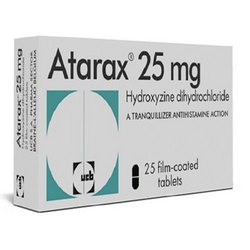Atarax
Atarax belongs to derived diphenylmethane. It has moderate anxiolytic activity; also has a sedative, antiemetic, antihistamine and m-anticholinergic effect. It blocks the central m-cholinergic receptors and histamine H1 receptors. It inhibits the activity of certain subcortical zones. It does not cause mental dependence and addiction. The clinical effect occurs 15-30 minutes after drug ingestion.
It has a positive effect on cognitive abilities, improves memory and attention. It relaxes skeletal and smooth muscles, has bronchodilating and analgesic effects, a moderate inhibitory effect on gastric secretion. Hydroxyzine significantly reduces itching in patients with urticaria, eczema, and dermatitis. With prolonged use, there is no marked withdrawal and cognitive decline.
Polysomnography in patients with insomnia and anxiety clearly demonstrates an increase in the duration of sleep, a decrease in the frequency of night awakenings after a single or repeated administration of hydroxyzine in a dose of 50 mg. A decrease in muscle tension in patients with anxiety was noted when taking the drug at a dose of 50 mg 3 times/day.
Indications
For adults:
- anxiety, psychomotor agitation, feelings of internal tension, increased irritability in case of neurological, mental (including generalized anxiety, adaptation disorders), somatic diseases, chronic alcoholism; withdrawal syndrome in chronic alcoholism, accompanied by psychomotor agitation;
- as a sedative during sedation;
- skin itching (as symptomatic therapy).
Dosage regimen
The drug is taken orally.
For symptomatic treatment of pruritus in children aged 12 months to 6 years, the drug is prescribed in a daily dose of 1-2.5 mg/kg body weight in several doses; children over the age of 6 years – at a dose of 1-2 mg/kg/ day in several doses.
For sedation in children, the drug is prescribed at a dose of 1 mg/kg body weight 1 hour before surgery, and also additionally on the night before surgery.
Adults for symptomatic treatment of anxiety are prescribed at a dose of 25-100 mg/day in several doses throughout the day or at night. The average dose is 50 mg/day. If necessary, the dose can be increased to 300 mg/day.
For symptomatic treatment of pruritus, the initial dose is 25 mg, if necessary, the dose can be increased 4 times (25 mg 4 times/day).
The maximum single dose should not exceed 200 mg, the maximum daily dose doesn’t exceed 300 mg.
In elderly patients, the initial dose should be reduced by 2 times.
Patients with moderate to severe renal insufficiency, as well as with hepatic failure, a dose reduction is required.
Side effect
Side effects associated with the anticholinergic effect: rarely (mainly in elderly patients) – dry mouth, urinary retention, constipation, accommodation disorder.
- Central nervous system: drowsiness, general weakness (especially at the beginning of treatment), headache, dizziness. If weakness and drowsiness do not disappear a few days from the start of therapy, the dose should be reduced. Very rarely (with a significant overdose) – tremor, convulsions, disorientation.
- Crdiovascular system: arterial hypotension, tachycardia.
- Digestive system: nausea, changes in liver function tests.
- Other: increased sweating, allergic reactions, fever, bronchospasm.
When using the drug in recommended doses, no clinically significant respiratory depression was noted. Involuntary motor activity (including very rare cases of tremor and convulsions), disorientation were observed with a significant overdose.
Side effects observed when taking Atarax, as a rule, are mild, transient. They disappear a few days from the start of treatment or after a dose reduction.
Contraindications
- Porphyria;
- Pregnancy;
- Period of labor;
- Lactation;
- Hypersensitivity to the components of the drug;
- Hypersensitivity to cetirizine and other piperazine derivatives, aminophylline or ethylenediamine.
Atarax tablets are not recommended for patients with hereditary galactose intolerance, as well as with impaired absorption of glucose and galactose, as the composition of the tablets includes lactose.
With caution, the drug should be prescribed for:
- myasthenia gravis, prostatic hyperplasia with clinical manifestations, difficulty with urinating, constipation, increased intraocular pressure, dementia, and a tendency to convulsive seizures; with a predisposition to the development of arrhythmia;
- the simultaneous use of drugs with arrhythmogenic effects;
- other drugs that depress the central nervous system, or anticholinergics (dose reduction is required).
A dose reduction is required in patients with severe and moderate hepatic impairment in renal failure, in elderly patients with a decrease in glomerular filtration.
